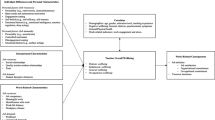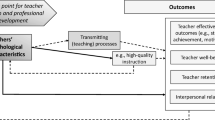Abstract
This study explored the relationship between distributed leadership and teachers’ sense of self-efficacy, with a focus on the mediating roles of job satisfaction and trust in the principal in the context of mainland China. Five hundred and seventy elementary school teachers in South China participated in a survey. The results show that distributed leadership has indirect effects on teachers’ self-efficacy, and that these effects are significantly mediated by job satisfaction and trust in the principal. The results highlight the importance of distributed leadership and trust in the principal in the Chinese context. Implications for the improvement of leadership practices are discussed.

Similar content being viewed by others
References
Bandura, A. (1997). Self-efficacy: The exercise of control. New York: Freeman.
Bryk, A., & Schneider, B. (2002). Trust in schools: A core resource for improvement. New York: Russell Sage Foundation.
Day, C., Sammons, P., Leithwood, K., Hopkins, D., Gu, Q., Brown, E., et al. (2011). School leadership and student outcomes: Building and sustaining success. Maidenhead, UK: Open University Press.
Dirks, K. T., & Ferrin, D. L. (2001). The role of trust in organizational settings. Organization Science, 12(4), 450–467.
Dou, D., Devos, G., & Valcke, M. (2017). The relationships between school autonomy gap, principal leadership, teachers’ job satisfaction and organizational commitment. Educational Management Administration & Leadership, 45(6), 959–977.
Hairon, S., & Goh, J. W. (2015). Pursuing the elusive construct of distributed leadership: Is the search over? Educational Management Administration & Leadership, 43(5), 693–718.
Hallinger, P. (2011). Leadership for learning: Lessons from 40 years of empirical research. Journal of Educational Administration, 49(2), 125–142.
Hallinger, P., Liu, S., & Piyaman, P. (2017). Does principal leadership make a difference in teacher professional learning? A comparative study China and Thailand. Compare,. https://doi.org/10.1080/03057925.2017.1407237.
Harris, A. (2008). Distributed leadership: According to the evidence. Journal of Educational Administration, 46(2), 172–188.
Harris, A. (2013). Distributed leadership: Friend or foe? Educational Management Administration & Leadership, 41(5), 545–554.
Harris, A. (2014). Distributed leadership matters. Thousand Oaks, CA: Corwin.
Hayes, A. F. (2009). Beyond Baron and Kenny: Statistical mediation analysis in the new millennium. Communication Monographs, 76(4), 408–420.
Heck, R. H., & Hallinger, P. (2009). Assessing the contribution of distributed leadership to school improvement and growth in math achievement. American Educational Research Journal, 46(3), 659–689.
Ho, C. L., & Au, W. T. (2006). Teaching satisfaction scale measuring job satisfaction of teachers. Educational and Psychological Measurement, 66(1), 172–185.
Hoftede, G., Hofstede, G. J., & Minkov, M. (2010). Cultures and organizations: Software of the mind (3rd ed.). New York: McGraw-Hill.
Hulpia, H., Devos, G., & Rosseel, Y. (2009). The relationship between the perception of distributed leadership in secondary schools and teachers' and teacher leaders' job satisfaction and organizational commitment. School Effectiveness and School Improvement, 20(3), 291–317.
Hulpia, H., Devos, G., & Van Keer, H. (2011). The relation between school leadership from a distributed perspective and teachers’ organizational commitment examining the source of the leadership function. Educational Administration Quarterly, 47(5), 728–771.
Klassen, R. M., & Chiu, M. M. (2010). Effects on teachers' self-efficacy and job satisfaction: Teacher gender, years of experience, and job stress. Journal of Educational Psychology, 102(3), 741–756.
Leithwood, K., & Beatty, B. (2008). Leading with teacher emotions in mind. Thousand Oaks, CA: Corwin Press.
Leithwood, K., Mascall, B., & Strauss, T. (2009). Distributed leadership according to the evidence. New York: Routledge.
Leithwood, K., Patten, S., & Jantzi, D. (2010). Testing a conception of how school leadership influences student learning. Educational Administration Quarterly, 46(5), 671–706.
Li, L., Hallinger, P., & Walker, A. (2015). Exploring the mediating effects of trust on principal leadership and teacher professional learning in Hong Kong primary schools. Educational Management Administration & Leadership, 44(1), 20–42.
Liu, S., Hallinger, P., & Feng, D. (2016). Supporting the professional learning of teachers in China: Does principal leadership make a difference? Teaching and Teacher Education, 59, 79–91.
Liu, S., Xu, X., Grant, L., Strong, J., & Fang, Z. (2017). Professional standards and performance evaluation for principals in China: A policy analysis of the development of principal standards. Educational Management Administration & Leadership, 45(2), 238–259.
Liu, Y., Bellibas, M. S., & Printy, S. (2018). How school context and educator characteristics predict distributed leadership: A hierarchical structural equation model with 2013 TALIS data. Educational Management Administration & Leadership, 46(3), 401–423.
Louis, K., Dretzke, B., & Wahlstrom, K. (2010). How does leadership affect student achievement? Results from a national US survey. School Effectiveness and School Improvement, 21(3), 315–336.
Mascall, B., Leithwood, K., Straus, T., & Sacks, R. (2008). The relationship between distributed leadership and teachers' academic optimism. Journal of Educational Administration, 46(2), 214–228.
Price, H. E. (2012). Principal–teacher interactions how affective relationships shape principal and teacher attitudes. Educational Administration Quarterly, 48(1), 39–85.
Qian, H., Walker, A., & Yang, X. (2017). Building and leading a learning culture among teachers: A case study of a Shanghai primary school. Educational Management Administration & Leadership, 45(1), 101–122.
Schreiber, J. B., Stage, F. K., King, J., Nora, A., & Barlow, E. A. (2006). Reporting structural equation modeling and confirmatory factor analysis results: A review. The Journal of Educational Research, 99(6), 323–337.
Skaalvik, E. M., & Skaalvik, S. (2011). Teacher job satisfaction and motivation to leave the teaching profession: Relations with school context, feeling of belonging, and emotional exhaustion. Teaching and Teacher Education, 27(6), 1029–1038.
Smylie, M., Mayrowetz, D., Murphy, J., & Louis, K. S. (2007). Trust and the development of distributed leadership. Journal of School Leadership, 17(4), 469–503.
Spillane, J. P. (2006). Distributed leadership. San Francisco, CA: Jossey-Bass.
Sun, A., & Xia, J. (2018). Teacher-perceived distributed leadership, teacher self-efficacy and job satisfaction: A multilevel SEM approach using the 2013 TALIS data. International Journal of Educational Research, 92, 86–97.
Tian, M., Risku, M., & Collin, K. (2016). A meta-analysis of distributed leadership from 2002 to 2013: Theory development, empirical evidence and future research focus. Educational Management Administration & Leadership, 44(1), 146–164.
Tschannen-Moran, M. (2014). Trust matters: Leadership for successful schools (2nd ed.). San Francisco, CA: Jossey-Bass.
Tschannen-Moran, M., & Gareis, C. R. (2015). Faculty trust in the principal: An essential ingredient in high-performing schools. Journal of Educational Administration, 53(1), 66–92.
Tschannen-Moran, M., & Hoy, A. W. (2001). Teacher efficacy: Capturing an elusive construct. Teaching and Teacher Education, 17(7), 783–805.
Van Maele, D., & Van Houtte, M. (2012). The role of teacher and faculty trust in forming teachers' job satisfaction: Do years of experience make a difference? Teaching and Teacher Education, 28(6), 879–889.
Van Maele, D., Forsyth, P. B., & Van Houtte, M. (2014). Trust and school life: The role of trust for learning, teaching, leading, and bridging. Dordrecht: Springer.
Wahlstrom, K. L., & Louis, K. S. (2008). How teachers experience principal leadership: The roles of professional community, trust, efficacy, and shared responsibility. Educational Administration Quarterly, 44(4), 458–495.
Walker, A., & Qian, H. (2018). Exploring the mysteries of school success in Shanghai. ECNU Review of Education, 1(1), 119–134.
Walker, A., Hu, R., & Qian, H. (2012). Principal leadership in China: An initial review. School Effectiveness and School Improvement, 23(4), 369–399.
Wong, L. N. (2003). Changing roles and shifting authority of principals in China: A mixed role of manager and clan leader. Education and Society, 21(2), 37–54.
Yin, H., & Zheng, X. (2018). Facilitating professional learning communities in China: Do leadership practices and faculty trust matter? Teaching and Teacher Education, 76, 140–150.
Zee, M., & Koomen, H. M. (2016). Teacher self-efficacy and its effects on classroom processes, student academic adjustment, and teacher well-being: A synthesis of 40 years of research. Review of Educational Research, 86(4), 981–1015.
Zheng, Q., Li, L., Chen, H., & Loeb, S. (2017). What aspects of principal leadership are most highly correlated with school outcomes in China? Educational Administration Quarterly, 53(3), 409–447.
Zheng, X., Yin, H., & Li, Z. (2018). Exploring the relationship between instructional leadership, professional learning communities and teacher self-efficacy in China. Educational Management Administration & Leadership,. https://doi.org/10.1177/1741143218764176.
Funding
This research was supported by Fundamental Research Funds for the Central Universities (SWU1809677), and Humanity and Social Science Youth Foundation Under Ministry of Education of China (19YJC880131).
Author information
Authors and Affiliations
Corresponding author
Additional information
Publisher's Note
Springer Nature remains neutral with regard to jurisdictional claims in published maps and institutional affiliations.
Rights and permissions
About this article
Cite this article
Zheng, X., Yin, H. & Liu, Y. The Relationship Between Distributed Leadership and Teacher Efficacy in China: The Mediation of Satisfaction and Trust. Asia-Pacific Edu Res 28, 509–518 (2019). https://doi.org/10.1007/s40299-019-00451-7
Published:
Issue Date:
DOI: https://doi.org/10.1007/s40299-019-00451-7




